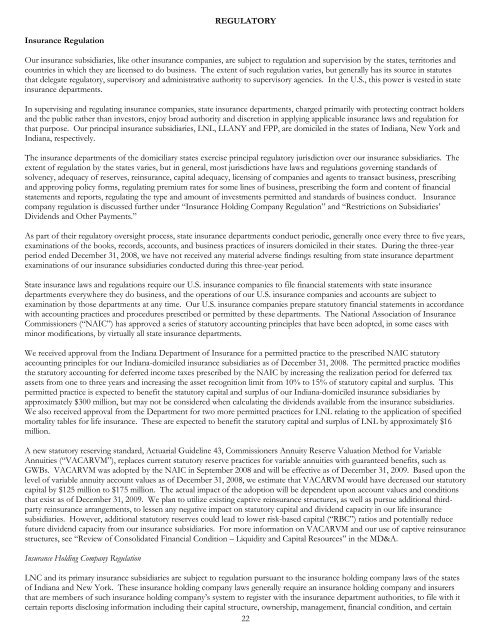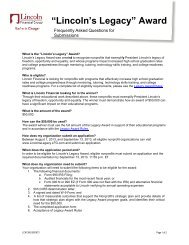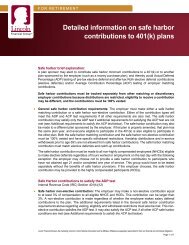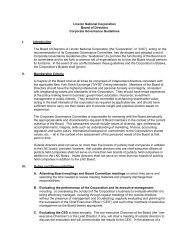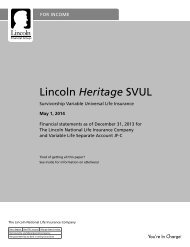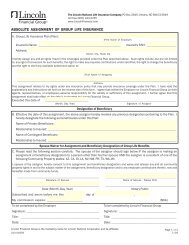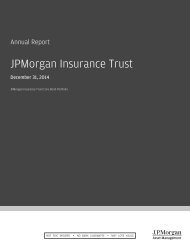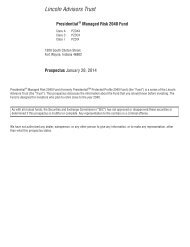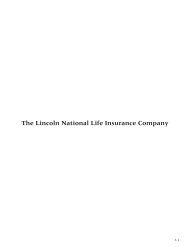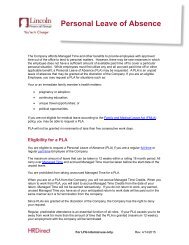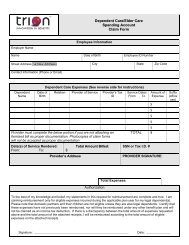2008 Annual Report to Shareholders - Lincoln Financial Group
2008 Annual Report to Shareholders - Lincoln Financial Group
2008 Annual Report to Shareholders - Lincoln Financial Group
Create successful ePaper yourself
Turn your PDF publications into a flip-book with our unique Google optimized e-Paper software.
REGULATORY<br />
Insurance Regulation<br />
Our insurance subsidiaries, like other insurance companies, are subject <strong>to</strong> regulation and supervision by the states, terri<strong>to</strong>ries and<br />
countries in which they are licensed <strong>to</strong> do business. The extent of such regulation varies, but generally has its source in statutes<br />
that delegate regula<strong>to</strong>ry, supervisory and administrative authority <strong>to</strong> supervisory agencies. In the U.S., this power is vested in state<br />
insurance departments.<br />
In supervising and regulating insurance companies, state insurance departments, charged primarily with protecting contract holders<br />
and the public rather than inves<strong>to</strong>rs, enjoy broad authority and discretion in applying applicable insurance laws and regulation for<br />
that purpose. Our principal insurance subsidiaries, LNL, LLANY and FPP, are domiciled in the states of Indiana, New York and<br />
Indiana, respectively.<br />
The insurance departments of the domiciliary states exercise principal regula<strong>to</strong>ry jurisdiction over our insurance subsidiaries. The<br />
extent of regulation by the states varies, but in general, most jurisdictions have laws and regulations governing standards of<br />
solvency, adequacy of reserves, reinsurance, capital adequacy, licensing of companies and agents <strong>to</strong> transact business, prescribing<br />
and approving policy forms, regulating premium rates for some lines of business, prescribing the form and content of financial<br />
statements and reports, regulating the type and amount of investments permitted and standards of business conduct. Insurance<br />
company regulation is discussed further under “Insurance Holding Company Regulation” and “Restrictions on Subsidiaries’<br />
Dividends and Other Payments.”<br />
As part of their regula<strong>to</strong>ry oversight process, state insurance departments conduct periodic, generally once every three <strong>to</strong> five years,<br />
examinations of the books, records, accounts, and business practices of insurers domiciled in their states. During the three-year<br />
period ended December 31, <strong>2008</strong>, we have not received any material adverse findings resulting from state insurance department<br />
examinations of our insurance subsidiaries conducted during this three-year period.<br />
State insurance laws and regulations require our U.S. insurance companies <strong>to</strong> file financial statements with state insurance<br />
departments everywhere they do business, and the operations of our U.S. insurance companies and accounts are subject <strong>to</strong><br />
examination by those departments at any time. Our U.S. insurance companies prepare statu<strong>to</strong>ry financial statements in accordance<br />
with accounting practices and procedures prescribed or permitted by these departments. The National Association of Insurance<br />
Commissioners (“NAIC”) has approved a series of statu<strong>to</strong>ry accounting principles that have been adopted, in some cases with<br />
minor modifications, by virtually all state insurance departments.<br />
We received approval from the Indiana Department of Insurance for a permitted practice <strong>to</strong> the prescribed NAIC statu<strong>to</strong>ry<br />
accounting principles for our Indiana-domiciled insurance subsidiaries as of December 31, <strong>2008</strong>. The permitted practice modifies<br />
the statu<strong>to</strong>ry accounting for deferred income taxes prescribed by the NAIC by increasing the realization period for deferred tax<br />
assets from one <strong>to</strong> three years and increasing the asset recognition limit from 10% <strong>to</strong> 15% of statu<strong>to</strong>ry capital and surplus. This<br />
permitted practice is expected <strong>to</strong> benefit the statu<strong>to</strong>ry capital and surplus of our Indiana-domiciled insurance subsidiaries by<br />
approximately $300 million, but may not be considered when calculating the dividends available from the insurance subsidiaries.<br />
We also received approval from the Department for two more permitted practices for LNL relating <strong>to</strong> the application of specified<br />
mortality tables for life insurance. These are expected <strong>to</strong> benefit the statu<strong>to</strong>ry capital and surplus of LNL by approximately $16<br />
million.<br />
A new statu<strong>to</strong>ry reserving standard, Actuarial Guideline 43, Commissioners Annuity Reserve Valuation Method for Variable<br />
Annuities (“VACARVM”), replaces current statu<strong>to</strong>ry reserve practices for variable annuities with guaranteed benefits, such as<br />
GWBs. VACARVM was adopted by the NAIC in September <strong>2008</strong> and will be effective as of December 31, 2009. Based upon the<br />
level of variable annuity account values as of December 31, <strong>2008</strong>, we estimate that VACARVM would have decreased our statu<strong>to</strong>ry<br />
capital by $125 million <strong>to</strong> $175 million. The actual impact of the adoption will be dependent upon account values and conditions<br />
that exist as of December 31, 2009. We plan <strong>to</strong> utilize existing captive reinsurance structures, as well as pursue additional thirdparty<br />
reinsurance arrangements, <strong>to</strong> lessen any negative impact on statu<strong>to</strong>ry capital and dividend capacity in our life insurance<br />
subsidiaries. However, additional statu<strong>to</strong>ry reserves could lead <strong>to</strong> lower risk-based capital (“RBC”) ratios and potentially reduce<br />
future dividend capacity from our insurance subsidiaries. For more information on VACARVM and our use of captive reinsurance<br />
structures, see “Review of Consolidated <strong>Financial</strong> Condition – Liquidity and Capital Resources” in the MD&A.<br />
Insurance Holding Company Regulation<br />
LNC and its primary insurance subsidiaries are subject <strong>to</strong> regulation pursuant <strong>to</strong> the insurance holding company laws of the states<br />
of Indiana and New York. These insurance holding company laws generally require an insurance holding company and insurers<br />
that are members of such insurance holding company’s system <strong>to</strong> register with the insurance department authorities, <strong>to</strong> file with it<br />
certain reports disclosing information including their capital structure, ownership, management, financial condition, and certain<br />
22


